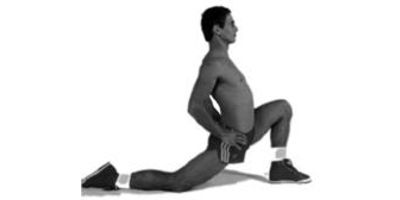Stretch Yourself: Testing Your Potential to Do a Front Split
This is the third installment of my column on training that appeared in May 1999 issue of TaeKwonDo Times.
To read the previous installment click here.
In the first article of this column (in TaeKwonDo Times March 1999) you learned how to determine if you have the potential to do a side split, even before you start your stretching program. In this article you will learn if the joints and muscles of your thighs and hips will permit you to do a front split.
Here is the front split test: Stand in a deep lunge. If your thighs are nearly in one line, as they would be in a front split, it means that your hip joints and their ligaments do not prevent you from doing the front split. Only tightness of your hamstring and calf muscles, and in some cases of the iliopsoas muscles, may keep you from sitting in a flat front split with both legs straight. With the right stretching method you will relax, or even elongate, these muscles and be able to do the front split with no warm-up.

In both the front split test and side split test, relieving the tension of the muscles around the joint increases the joint’s range of motion, proving that only muscular tension prevents you from doing splits. Muscular tension has two components: the tension generated by the contractile elements (muscle fibers) and the tension present even in an inactive, denervated muscle, exerted by the connective tissues associated with the muscle.
Some authors (M. J. Alter, B. Anderson, H. A. deVries, S. A. Sölveborn) claim the connective tissue tension to be the main factor restricting flexibility. They advocate slow static stretching, even in a warm-up, as if muscles were pieces of fabric to be elongated to a desired size. Ramsey and Street (1940), however, prove and state clearly that if the range of extension does not exceed 130% of resting length (30% more than resting length), the resting tension in a noncontracting muscle is very small. (The resting length of a muscle is the length of an uncontracted and unstretched muscle in the body.)
Also, Shottelius and Senay (1956) show that, in a muscle stretched to well over 100% of its resting length, the passive tension generated by its connective tissue is a small fraction of the tension due to active contraction. They show that eventually, at approximately 120% of a muscle’s resting length, the two components of muscle tension contribute equally to total tension. At greater lengths, the passive tension increases while the active tension, generated by contracting muscle fibers, decreases.
For practical purposes, as long as you feel your muscles contract in response to a stretch, it means that relaxing them can improve your stretch and that you should concern yourself more with nervous regulation of the muscles’ tension and less with the muscles’ connective tissue. This concept is most strikingly demonstrated in the side split test shown in the March 1999 issue of TaeKwonDo Times.
In the next column you will learn about kinds of flexibility and about the role of splits in taekwondo, karate, and kickboxing. (If you think splits are necessary for kicking high, you are wrong.)
To read the next installment of this column click here.
This article is based on the book Stretching Scientifically.
This article is copyrighted © [March 1999] by Stadion Publishing Company, Inc. and posted with their permission. Original articles of Thomas Kurz’s column on stretching and training are athttps://www.stadion.com/articles-on-training-for-sports-and-martial-arts/
References
Alter, M. J. 1988. Science of Stretching. Champaign, IL: Human Kinetics
Anderson, B. 1980. Stretching. Bolinas, CA: Shelter Publications, Inc.
deVries, H. A. 1980. Physiology of Exercise for Physical Education and Athletics. Dubuque: Wm. C. Brown Company Publishers
Ramsey, R. W., Street, S. F. 1940. “Isometric length tension diagram of isolated skeletal muscle fibers of the frog.” Journal of Cellular and Comparative Physiology 15:11
Schottelius, B. A., Senay, L. C. 1956. “Effect of stimulation-length sequence on shape of length-tension diagram.” American Journal of Physiology 186:127-130
Sölveborn, S. A. 1989. Stretching. Warszawa: Sport i Turystyka











